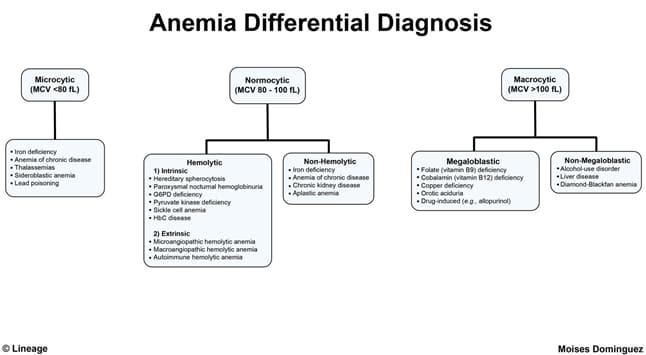Snapshot
- A 35-year-old man presents to the clinic for follow-up for treatment of latent tuberculosis. He is a recent immigrant to the United States from Mexico and started taking isoniazid 2 months ago after he was diagnosed with latent tuberculosis at an occupational health visit. Physical examination is notable for decreased sensation to pinprick in his lower extremities. A bone marrow aspirate is obtained and after staining with Prussian blue, the finding in the image is observed.
Introduction

- Overview
- Epidemiology
- incidence
- rare
- demographics
- X-linked recessive type of inherited sideroblastic anemia occurs more commonly in males
- median age of occurence of primary acquired sideroblastic anemia is 74 years of age
- risk factors
- alcoholism
- vitamin B6 deficiency
- lead poisoning
- copper deficiency
- incidence
- Pathophysiology
- pathophysiology
- mitochondrial pathways in erythrocyte precursors are disrupted, leading to accumulation of iron in the mitochondria
- excessive iron deposits in erythroblasts form a ring around the nucleus, making a ringed sideroblast
- heme synthesis is impaired, leading to ↓ heme production and abnormal RBCs (see Heme Metabolism)
- X-linked sideroblastic anemia
- mutation in ALAS2 gene which encodes ALA synthase, the first enzyme of the heme synthesis pathway
- vitamin B6 (pyridoxine) is a necessary cofactor for ALA synthase
- mutation in ALAS2 gene which encodes ALA synthase, the first enzyme of the heme synthesis pathway
- isoniazid
- disrupts conversion of vitamin B6 (pyridoxine) to its active cofactor
- chronic alcohol use
- impairs vitamin B6 metabolism
- toxic effects on mitochondrial protein synthesis
- lead poisoning
- inhibits several enzymes involved in heme synthesis
- ALA dehydratase
- ferrochelatase
- inhibits several enzymes involved in heme synthesis
- X-linked sideroblastic anemia
- mitochondrial pathways in erythrocyte precursors are disrupted, leading to accumulation of iron in the mitochondria
- pathophysiology
- Genetics
- inheritance pattern
- X-linked (inherited sideroblastic anemia)
- mutations
- ALAS2 gene
- encodes for ALA synthase
- ALAS2 gene
- inheritance pattern
- Prognosis
- highly variable depending on cause
- anemia due to reversible causes (i.e., alcohol and drugs) do not have long-term sequelae
- highly variable depending on cause
- secondary hemochromatosis (from transfusions) and leukemia are major causes of death
Presentation
- Symptoms
- lack of coordination (cerebellar symptoms)
- diarrhea
- Physical exam
- growth delay in children
- ataxia
- ↓ deep-tendon reflexes
- incoordination
- dyspnea
- muscular weakness
Studies
- Serum labs
- ↑ serum iron and ferritin
- ↓ TIBC
- ↓ or normal MCV
- Histology
- peripheral blood smear
- hypochromic RBCs
- low reticulocyte count
- bone marrow stained with Prussian blue
- ringed sideroblasts
- peripheral blood smear
- diagnostic hallmark of all sideroblastic anemias
Differential
- Iron deficiency anemia
- key distinguishing factor
- ↓ serum iron and ferritin
- key distinguishing factor
- Megaloblastic anemia
- key distinguishing factor
- megaloblastic changes seen on peripheral blood smear and bone marrow rather than ringed sideroblasts
Treatment
- Medical pyridoxine (vitamin B6) supplementation


